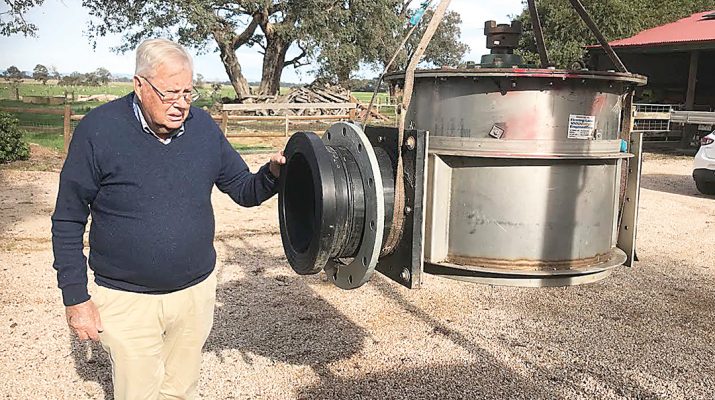Philip Hopkins
PUMPED hydro energy storage is a technology that has existed for more than a century and is used in countless countries around the world.
The technology involves storing water, pumped from a lower reservoir, into an upper reservoir. Power is generated by releasing the stored water through turbines, but when power demand is low, the upper reservoir is recharged by using lower-cost electricity from the grid to pump the water back to the upper reservoir.
In Victoria, the electricity was traditionally sourced from the Latrobe Valley’s brown coal power stations. Now, a Gippslander is convinced he has produced technology that can pump the water back uphill without using fossil fuel energy.
“We’ve designed a turbine that’s slow-revving. We have done one that produces 25 horsepower drive and a five horsepower turbine that turns into a pump. With a one-metre head on the larger one, we can push the water up 12 metres fossil-free,” said Fred Sundermann who lives between Cowwarr and Heyfield.
“We don’t have to have a generator like now; we can do it via turbine to turbine, which saves the loss of electricity and is much more efficient.”
Mr Sundermann, with a life-long interest in design and innovation, has form as an inventor of agricultural machinery. Seventy years ago, he invented a tractor with disc brakes and a two-stage clutch, which had never been heard of before; and also a finger wheel rake and harvester that was featured in a Landline program 17 years ago on the ABC. He also built a 40-metre bridge across the Rainbow Creek on a Cowwarr property that is still functioning today.
Now, Mr Sundermann likes to call his new water turbine the first pump hydro made that doesn’t need fossil fuel – and it’s made in Gippsland.
The water pump is mechanically driven by a modular micro hydro turbine that uses the free flow of a river or stream. A prototype has been made by a Morwell light and heavy engineering manufacturer, Firmins Lane Engineering, which builds and maintains turbines for Snowy Hydro, and “it’s well made’’, Mr Sundermann said.
The submerged water turbine, which drives a generator, has been specifically designed to maximise operational efficiency in slow to medium water flows of 6-12 knots.
Mr Sundermann said this concept – the generator driven by the water turbine utilising the water flow controlled by the operator – is ideal where grid power is unavailable or unreliable, or becoming too expensive, or can be supplemented from accessible water flows.
By generating free electrical energy from stream flows, potential applications include remote off-grid locations and communities; irrigation channels and pipelines for on-farm use – generator output can be matched to flow periods; waste/wastewater treatment plants; or tidal areas where the water flow reverses direction about every six hours.
Each turbine delivers up to 100 kW of power and multiple turbines can be combined to form a larger working unit, or “bank” delivering up to 1 MW per bank.
The technology’s advantage over other turbines is that the power blades tilt during a rotating cycle.
The turbine has a unique design; its efficiency is achieved by the tilting of the power blades during the rotating cycle. The blades rotate half a revolution for each full rotation of the central shaft.
This configuration allows each blade to contribute a unidirectional force to the central shaft, for virtually the entire rotational cycle. In this way, the blades can efficiently utilise the kinetic energy of the moving water. The central shaft drives the generator via a gearbox to produce emission free renewable energy.
“I built the first turbine about 17 years ago and have been refining it since,” Mr Sundermann said.
His water turbine was at one stage an Australian Clean Tech finalist.
Retirement has given him the opportunity to concentrate on the venture, resulting in the ability to pump uphill.
“You can have a generator, but I came up with the idea of a spillway. we can push the water up 12 metres,” Mr Sundermann said. Snowy Hydro, for example, could have 30 metres of head that could easily push 80 metres up to a reuse dam.
“We can recycle 20 per cent of the water going passed out of the spillway dam up to the reuse dam; 20 per cent of the water goes up into the dam fossil-free,” he said.
Mr Sundermann has formed a company to commercialise the invention. His company team includes experienced Latrobe Valley executive and consultant John Mitchell, whose background includes local government, and water, sewerage and resource management; and Dr Ulrich Hartig, a chemical engineer and former senior manager of the BASF Group who has more than 35 years’ experience in Australia, France, Germany, South Korea, Brazil and Canada.
Mr Sundermann’s life has always included helping people; he started a men’s club in Heyfield and has been a Legacy officer.
“I have always been interested in renewable energy and thought this idea would help the environment,” he said.
Fred Sundermann is happy with his turbine design and is looking for a manufacturer. It’s hard to get off the ground, but it’s up for sale to be manufactured.

